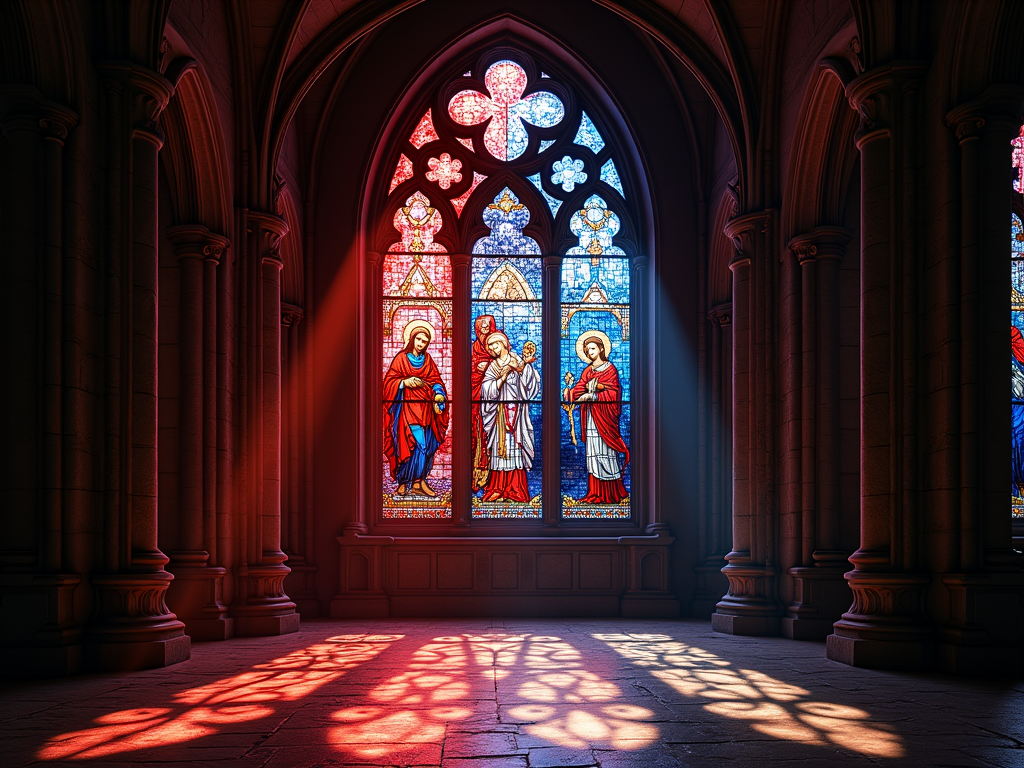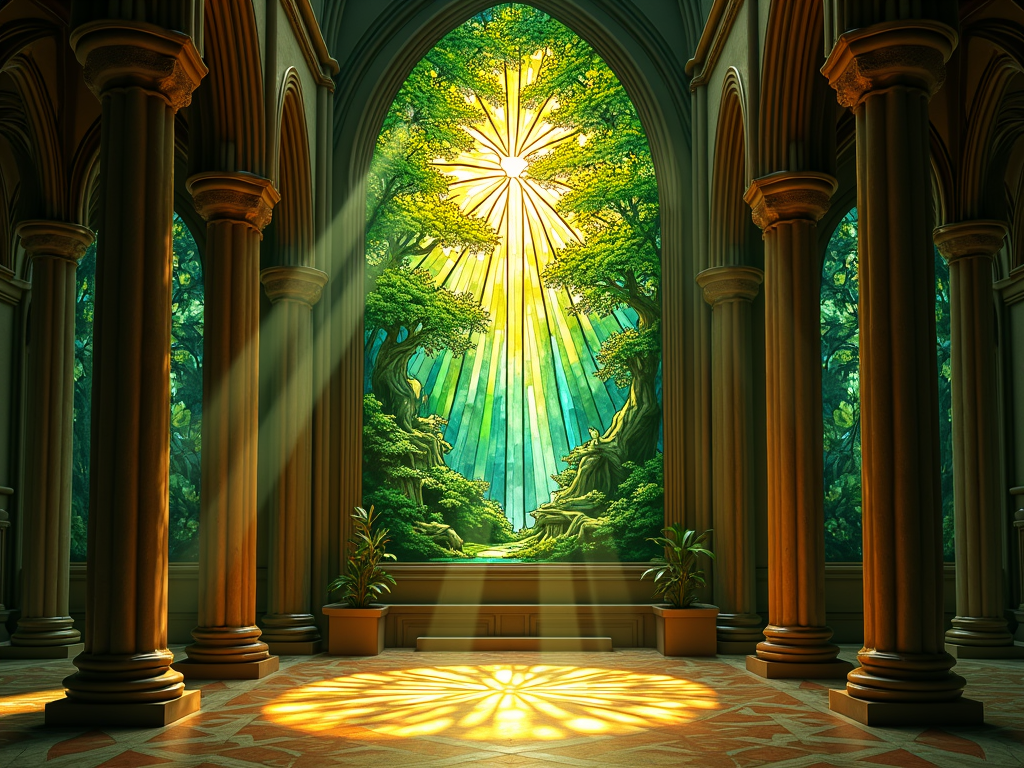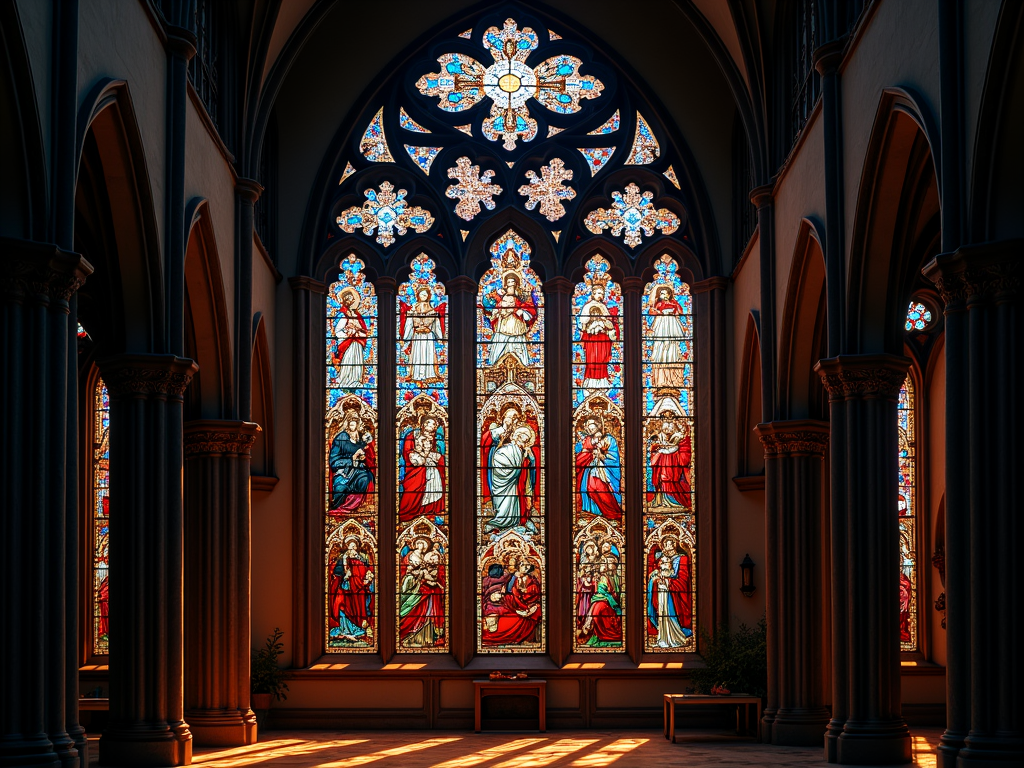
Religious architecture’s stained glass serves as a visual language of faith through symbolic colors. Each hue connects worshippers to sacred stories and spiritual concepts. Medieval artisans perfected techniques like the renowned “Chartres Blue” to inspire divine contemplation.
Key Takeaways
- Purple signifies royal authority and spiritual transformation, particularly during Lent and Advent.
- Green represents new life, paradise gardens, and spiritual growth.
- Gold and Yellow symbolize divine power, heavenly glory, and spiritual enlightenment.
- Red depicts Christ’s blood, divine love, and martyrdom.
- White represents purity, divine revelation, and heavenly presence.
I find the color choices in religious stained glass tell powerful stories without words. The deep red glass speaks of sacrifice and holy love, while blue glass points to celestial realms and honors the Virgin Mary. These color selections shaped how people experienced sacred spaces for centuries.
The artistry involved precise techniques passed down through generations of craftspeople. Their mastery created windows that transformed sunlight into spiritual illumination. The colors remain vital elements in modern religious architecture, carrying forward ancient symbolic traditions.
The Sacred Symbolism Behind Red and Blue in Religious Windows
Deep Meanings in Sacred Colors
Red and blue stand out as two of the most powerful colors in religious stained glass symbolism. I’ve found that red carries multiple layers of sacred meaning in historical church windows, each shade telling its own story. Deep crimson red represents the ultimate sacrifice and martyrdom, while brighter shades point to the presence of the Holy Spirit and acts of charity.
Blue has earned its place as a central color in medieval stained glass traditions. The stunning windows of Chartres Cathedral showcase what’s now known as ‘Chartres blue‘ – a distinctive shade that’s captured imaginations for centuries. This rich color speaks to truth and divine wisdom, while lighter blues lift thoughts toward heaven.
In biblical stained glass scenes, these colors play specific roles:
- Red tones symbolize:
- Christ’s blood and sacrifice
- Divine love and passion
- Martyrdom and courage
- The Holy Spirit’s presence
- Acts of charity
- Blue shades represent:
- The Virgin Mary’s purity
- Heaven and celestial realms
- Divine truth and wisdom
- Spiritual depth
- Sacred mysteries
The combination of red and blue creates a powerful visual language in religious windows. Deep blues draw viewers into contemplation of spiritual mysteries, while vibrant reds remind us of divine love and sacrifice. Light blue sections lift our gaze upward, suggesting heavenly realms, while crimson elements ground us in the physical reality of sacrifice and martyrdom.
I’ve noticed how medieval artisans used these colors to tell stories without words, helping illiterate congregations understand sacred teachings through visual symbolism. The careful placement of each color created layers of meaning that still resonate in modern religious spaces.

Nature’s Divine Messages: Green and Gold in Stained Glass
The Sacred Symbolism of Earth’s Colors
The vibrant green tones in stained glass art symbolism carry deep spiritual meaning, drawing directly from nature’s eternal cycle of growth and renewal. I’ve noticed that artisans frequently use green glass to depict scenes from the Garden of Eden, where this color represents the pure and untouched natural world. When you spot green in historical stained glass windows, it’s often tied to themes of resurrection and eternal life.
Gold and yellow bring a different but equally powerful dimension to biblical stained glass scenes. These radiant hues are the traditional colors of divine power and heavenly glory. I’ve seen how master craftsmen use gold leaf to create stunning effects that seem to capture sunlight itself, making celestial scenes come alive with supernatural brilliance. Yellow serves a dual purpose in these artworks – it guides your eye through the composition while representing spiritual enlightenment.
Symbolism of Colors in Religious Stained Glass
Here’s what each color typically represents in religious stained glass:
- Green: New life, paradise gardens, hope, and growth
- Dark green: The natural world and earthly existence
- Bright green: Spring renewal and spiritual rebirth
- Gold: Divine power, heavenly realms, and eternal glory
- Yellow: Spiritual illumination, divine wisdom, and enlightenment
- Pale yellow: Youth, innocence, and purity
These fascinating aspects of stained glass show how medieval artists used color to tell complex spiritual stories. The way sunlight streams through these carefully chosen hues creates an ever-changing display throughout the day, bringing these ancient symbols to life in modern times. The harmonious blend of greens and golds continues to inspire awe and contemplation, just as it did centuries ago.

Royal Purple and Pure White: Colors of Majesty and Grace
I find that purple and white play pivotal roles in traditional stained glass symbolism. Purple stands as a remarkable symbol of royal authority and spiritual transformation in church windows. This deep, rich hue carries significant weight in religious symbolism and meaning, particularly during key liturgical seasons.
The Spiritual Significance of Purple and White
Purple glass captures attention in church windows during Lent and Advent, serving as a reminder of Christ’s suffering and the call to spiritual reflection. Its connection to royalty dates back to ancient times when purple dye was incredibly rare and expensive, making it accessible only to the wealthy and powerful.
White glass brings a different but equally important dimension to stained glass artwork. I’ve noticed its powerful effect in creating scenes of divine revelation and heavenly presence. This pure hue is often used to depict:
- Angels appearing in biblical narratives
- Saints in moments of spiritual triumph
- The resurrected Christ in glory
- Divine light breaking through darkness
- Heavenly clouds and celestial beings
The combination of purple and white in historical stained glass windows creates a striking visual message about the relationship between earthly power and divine grace. White’s natural luminosity makes it perfect for portraying supernatural elements, while purple grounds these celestial scenes in the reality of spiritual authority and sacrifice.
In biblical stained glass scenes, purple often appears in the robes of kings and church leaders, while white illuminates the background or heavenly figures. This intentional color placement helps viewers understand the story’s spiritual hierarchy and meaning without needing words.
The Warm Glow: Understanding Orange in Modern Glass
Orange holds a special place in stained glass color symbolism, blending the passionate energy of red with the radiant warmth of yellow. I’ve noticed this vibrant hue gaining prominence in modern stained glass designs, though its journey hasn’t always been straightforward.
The Evolution of Orange in Sacred Spaces
Historically, orange was a challenging color to achieve in traditional stained glass artwork, making it relatively rare in ancient churches and cathedrals. The technical limitations of medieval glass-making meant that creating consistent orange hues proved difficult. Today’s advanced manufacturing techniques have opened up new possibilities, letting artists fully embrace orange’s powerful symbolic meaning.
In contemporary religious stained glass windows, orange represents:
- Endurance during spiritual journeys
- Physical and mental strength
- Natural vitality and life force
- The warmth of divine presence
- Energy and enthusiasm in faith
Modern spiritual spaces are increasingly incorporating orange into their stained glass installations, creating dramatic effects when paired with complementary colors. I’ve seen stunning examples where orange sections catch the morning light, filling spaces with a warm, welcoming glow. This transformative quality makes it perfect for meditation areas and spaces dedicated to spiritual growth.
The color’s natural association with sunset and harvest seasons adds depth to its spiritual significance. Orange brings balance to cooler tones in stained glass compositions, creating visual harmony while symbolizing the bridge between physical and spiritual realms. Its growing popularity in contemporary designs reflects our modern understanding of color psychology and its impact on spiritual experiences.
When combined with blues or purples, orange creates striking contrasts that draw the eye and inspire contemplation. This bold interplay of colors can transform ordinary spaces into extraordinary ones, making orange an increasingly valuable tool in modern stained glass artistry.
Artistic Techniques in Sacred Glass
The careful selection of colors in stained glass creates a powerful visual and spiritual impact in sacred spaces. Through my experience studying symbolic meaning in stained glass art, I’ve discovered how color combinations work together to tell meaningful stories.
Color Selection and Symbolism
Medieval artisans faced significant challenges in creating their desired colors, yet they developed ingenious techniques to produce vivid hues. I can tell you that the deep blues and rich reds found in historical stained glass windows required specific mineral compounds and precise firing temperatures.
Clear or lightly tinted glass serves as an essential element in sacred windows, representing purity and divine light. Gold leaf application adds radiance and highlights key religious figures, with medieval craftsmen pressing thin sheets between glass layers to achieve a luminous effect.
The symbolic power of different colors shapes the spiritual message:
- Red represents Christ’s sacrifice, martyrdom, and divine love.
- Blue symbolizes heaven, the Virgin Mary, and spiritual devotion.
- Green indicates growth, hope, and life’s renewal.
- Purple denotes royalty, justice, and Christ’s passion.
- White reflects purity, innocence, and divine light.
- Yellow or gold represents divine glory and heavenly wisdom.
Modern stained glass artists take a different approach to color than their medieval counterparts. While traditional stained glass techniques relied on thick, deeply saturated colors, contemporary artists often use lighter tints and broader color palettes to create subtle effects.
Balance and contrast play crucial roles in stained glass design. I’ve found that pairing complementary colors like blue and orange or purple and yellow creates striking visual impact. The placement of dark and light elements guides the viewer’s eye through biblical narratives depicted in church windows.
These artistic decisions aren’t random – they’re carefully planned to enhance both the aesthetic appeal and spiritual message of each piece. Light streaming through colored glass transforms interior spaces throughout the day, creating an ever-shifting display that connects viewers to the divine through color and light.

Famous Examples of Symbolic Color Use
Medieval Masterpieces
I’ve witnessed firsthand how symbolic colors in stained glass windows come alive in Europe’s great cathedrals. Chartres Cathedral sets the standard with its distinctive blue windows, known as “Chartres Blue.” This rare and precious color represented the Virgin Mary and heaven’s infinite expanse, creating an ethereal atmosphere that still captivates visitors today.
Canterbury Cathedral tells its stories through a rich tapestry of colors that have lasted centuries. The historical pieces there showcase how medieval stained glass evolved from simple designs to complex narratives. Red dominates many scenes depicting martyrdom, while gold halos surround sacred figures, demonstrating the careful thought behind each color choice.
Sainte-Chapelle in Paris stands as perhaps the most stunning example of color symbolism in stained glass. Its 15 towering windows use a calculated arrangement of colors to tell biblical stories. The deep reds and blues create a jewel-box effect that bathes visitors in colored light, making it one of the finest examples of 13th-century craftsmanship.
Biblical Scenes and Modern Interpretations
Crucifixion scenes across various churches display particularly meaningful biblical symbolism through stained glass. Purple often appears in these windows to represent Christ’s suffering and royalty, while white signifies his purity and triumph over death. These color choices weren’t random – they reflected deep theological meanings that medieval churchgoers would have understood.
Garden of Eden depictions make extensive use of emerald greens and earthy browns to portray paradise. I’ve noticed these scenes often incorporate golden yellows for divine light and deep blues for the waters of creation. The green glass used in these windows serves as a reminder of growth, renewal, and God’s natural world.
Modern churches have put fresh spins on traditional color symbolism. Contemporary artists mix bold color combinations while maintaining the spiritual significance behind their choices. Here are some common interpretations found in modern stained glass:
- Clear glass represents purity and God’s light
- Orange symbolizes the fire of the Holy Spirit
- Yellow depicts divine glory and enlightenment
- Purple indicates royalty and spiritual wealth
- Green shows growth and eternal life
These fascinating aspects of stained glass continue to inspire artists and architects. Modern interpretations might use abstract patterns or simplified figures, but they maintain the powerful impact of color symbolism that has moved people for centuries.
Sources:
The Stained Glass Association of America
The Meaning of Colors in Stained Glass
Chartres Cathedral
Canterbury Cathedral
Sainte-Chapelle
